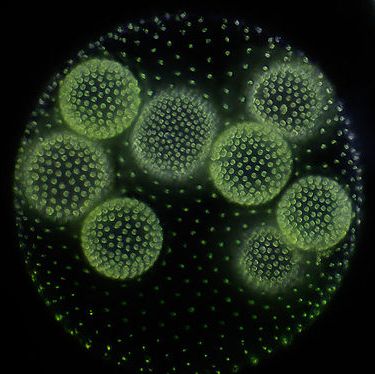
Volvox, volvox reproduction, and what we learn from volvox morphogenesis are not your typical high school topic.
Yes, biology is a standard college preparatory course. If it weren’t for dissection, it would probably be one of the most popular sciences. Especially would that be so of the fascinating tiny, one-celled creatures. These include:
1. Amoeba
2. Paramecium
3. Euglena1
4. Hydra
We learned about small plant forms as well, including:
1. Molds
2. Algae
3. Mosses
4. Lichens
We will discuss one form of algae, Volvox of the family Volvocaceae. There are a number of forms of algae. Volvox is one of the green algae – a chlorophyte. Volvox is unique among the chlorophytes. It is most unusual in structure and in behavior. While each is an individual, it lives communally, acting like a single multicellular organism.
The Structure of Volvox
Volvox (see photo) are tiny spheres within a larger sphere, somewhat resembling nuclei within a cell. The difference is that each individual within is complete within itself. In fact, a large colony may contain smaller colonies that contain volvox individuals.
But perhaps this reminds you of one of the following… Ever seen Matryoshka nested Russian dolls? Or nested carved ivory balls made from one tusk? What about the “mother-of-millions” plant? If you enjoy mathematics, perhaps you are familiar with fractals?
Volvox Reproduction
Volvox is one of those creatures that can multiply in two ways, asexually and sexually. Asexual reproduction involves simple cell splitting.
Volvox sexual reproduction is featured in the following video.
Inside-Out
Scientists are scrutinizing the fascinating process whereby volvox turns itself inside out. They liken this to gastrulation, the process why which animal cells change into the various organs in the body.
The University of Cambridge provides here a video of the process (morphogenesis).
1 Life forms are generally categorized into plant and animal kingdoms. Due to possessing some animal-like characteristics and some plant-like characteristics, both, some scientists assign the euglena to another kingdom, the Protists. In connection with this, see my commentary Euglena Plant or Animal – or Is It a Protist?
Note: You might also enjoy Vorticella – A Living Spring
References:
- Microscopy – UK: Volvox, one of the 7 Wonders of the Micro World
- YouTube: “Volvox Dances” by Hidden Communities
- YouTube: “Sexual Reproduction in Volvox” by Natural and Applied Science
